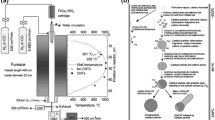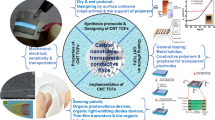Abstract
Carbon nanotubes (CNTs) can be used as channel material in a nanoscale or microscale gap between conducting electrodes. The contact potential of CNT-bundles deposited by inkjet-printing was measured by KFM (Kelvin probe force microscopy) using Pt-coated Si tips in ultra-high vacuum (~10–8 Pa). By comparing these results with electrical characteristics, SEM (scanning electron microscopy) and AFM (atomic force microscopy) measurements, we confirmed that the inkjet-printed CNT-bundles bridged the nanogap between different electrodes. Using this KFM technique, it can be shown how the potential of the CNT-bundles changes under the application of voltages. Combining these results, we investigate the electrical properties of CNT-networks deposited on CMOS-compatible platforms, aiming towards the development of hybrid nanoelectronics.
Access this chapter
Tax calculation will be finalised at checkout
Purchases are for personal use only
Similar content being viewed by others
References
Moore, G.: Cramming more components onto integrated circuits. Electron. Mag. 38, 114–117 (1965)
Waldrop, M.M.: The chips are down for Moore’s law. Nat. News 530, 144–147 (2016)
Chau, R., Doyle, B., Datta, S., Kavalieros, J., Zhang, K.: Integrated nanoelectronics for the future. Nat. Mater. 6(11), 810–812 (2007)
De Volder, M.F., Tawfick, S.H., Baughman, R.H., Hart, A.J.: Carbon nanotubes: present and future commercial applications. Science 339, 535–539 (2013)
Lee, D., et al.: High-performance thin-film transistors produced from highly separated solution-processed carbon nanotubes. Appl. Phys. Lett. 104, 143508 (2014)
Choi, S.J., Wang, C., Lo, C.C., Bennett, P., Javey, A., Bokor, J.: Comparative study of solution-processed carbon nanotube network transistors. Appl. Phys. Lett. 101, 112104 (2012)
Choi, S.J., Bennett, P., Lee, D., Bokor, J.: Highly uniform carbon nanotube nanomesh network transistors. Nano Res. 8, 1320–1326 (2015)
Singh, R.S., et al.: Precise deposition of carbon nanotube bundles by inkjet-printing on a CMOS-compatible platform. Materials 15, 4935 (2022)
Tabe, M., et al.: Single-electron transport through single dopants in a dopant-rich environment. Phys. Rev. Lett. 105, 016803 (2010)
Ligowski, M., Moraru, D., Anwar, M., Mizuno, T., Jablonski, R., Tabe, M.: Observation of individual dopants in a thin silicon layer by low temperature Kelvin Probe Force Microscope. Appl. Phys. Lett. 93, 142101 (2008)
Anwar, M., et al.: Effect of electron injection into phosphorus donors in silicon-on-insulator channel observed by Kelvin probe force microscopy. Appl. Phys. Lett. 99, 213101 (2011)
Tyszka, K., Moraru, D., Samanta, A., Mizuno, T., Jablonski, R., Tabe, M.: Comparative study of donor-induced quantum dots in Si nano-channels by single-electron transport characterization and Kelvin probe force microscopy. J. Appl. Phys. 117, 244307 (2015)
Tyszka, K., Moraru, D., Samanta, A., Mizuno, T., Jablonski, R., Tabe, M.: Effect of selective doping on the spatial dispersion of donor-induced quantum dots in Si nanoscale transistors. Appl. Phys. Express 8, 094202 (2015)
Acknowledgments
This work was partially supported by JSPS KAKENHI (no. 19K04529 and no. 22K04216), and a Cooperative Research Project from the Research Institute of Electronics, Shizuoka University. The authors thank K. Takagi, T. Aoki, J. H. Moon, Y. Neo, F. Iwata, and H. Mimura for their support during the inkjet-printing and AFM manipulation, as well as for useful discussions.
Author information
Authors and Affiliations
Corresponding author
Editor information
Editors and Affiliations
Rights and permissions
Copyright information
© 2024 The Author(s), under exclusive license to Springer Nature Switzerland AG
About this paper
Cite this paper
Kawanishi, H., Singh, R.S., Ramakrishnan, V.N., Shimomura, M., Moraru, D. (2024). Comparative Evaluation of Electrical Properties of Carbon Nanotube Networks Deposited on CMOS-Compatible Platform. In: Ono, Y., Kondoh, J. (eds) Recent Advances in Technology Research and Education. Inter-Academia 2023. Lecture Notes in Networks and Systems, vol 939. Springer, Cham. https://doi.org/10.1007/978-3-031-54450-7_9
Download citation
DOI: https://doi.org/10.1007/978-3-031-54450-7_9
Published:
Publisher Name: Springer, Cham
Print ISBN: 978-3-031-54449-1
Online ISBN: 978-3-031-54450-7
eBook Packages: Intelligent Technologies and RoboticsIntelligent Technologies and Robotics (R0)




